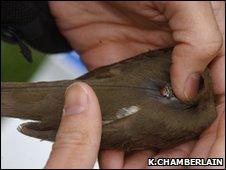Urban trees 'help migrating birds'
- Published

The researchers fitted tags, weighing 0.66g, to 91 Swainson's thrushes
Even a small urban forest can help migrating birds, a study has said.
US researchers found that birds used the patches of greenery to rest and refuel in the middle of their journey between winter and breeding sites.
The scientists gathered the data by fitting tiny tags to thrushes, which recorded the birds' movements.
Writing in the journal Landscape Ecology, they added the findings were important because the world was becoming increasingly urbanised.
"With the expansion of urban areas worldwide, migrating songbirds increasingly encounter fragmented landscapes where habitat patches are embedded in an urban matrix," wrote co-authors Stephen Matthews and Paul Rodewald, landscape ecologists at Ohio State University in the US.
"Yet, how migrating birds respond to urbanisation is poorly understood."
Unique data
In order to learn more, the pair attached small tags to more than 100 Swainson's thrushes (Catharus ustulatus) and managed to gather data on the movements of 91 birds during the four-year study.
"The tags provided us with a unique data-set on migration during a stopover," Dr Matthews told BBC News.
"We were able to record how long the birds were staying, and we found that it was not necessarily the forest size that was influencing the birds.
"Instead, they were responding to internal factors, such as [the amount of] fat reserves they had."
He added that the importance of the urban tree cover was highlighted when they examined the area the birds were using to forage for food.
"We started to see the importance of these smaller forest patches.
"The birds ability to search around was limited by the extent of these forested areas."
The study examined seven urban forests, the smallest of which was an arboretum that covered less than one hectare.
"It seemed that the birds were able to utilise these small forest patches during their stopover," Dr Matthews observed.
"In five of the sites, the birds never left the forest patch... and were not exploring in folks' backyards."
The team collected the data by using radio-transmitter tags.
"The tags were very small, weighing an average of 0.66g, and we glued them to the back feathers of the birds using a very mild adhesive," he explained.
"The battery life only lasted a couple of weeks, so the transmitter just fell off after a short while."
Dr Matthews said the tiny tags emitted a signal that they could pick up via a hand-held receiver and record the birds' locations.
"We recorded the GPS location, and then we would go back and do the analysis [of the birds' movements] later. It would have been nice if it was all automated, but there was a little bit of fieldwork involved.
The researchers said that migration had been identified as a critical period in the annual cycle of migratory birds.
"Within migration, land birds spend up to 90% of their time resting and regaining energy at stopover sites, making habitat a key component," they explained.
"This information is necessary to evaluate the conservation importance of urban habitats for stopover migrants."
"These findings suggest that remnant forests within urban areas have conservation value for Swainson's thrushes and, potentially, other migrant land birds," Professor Rodewald said.
"Obviously, larger forest patches are better, but even smaller ones are worth saving."